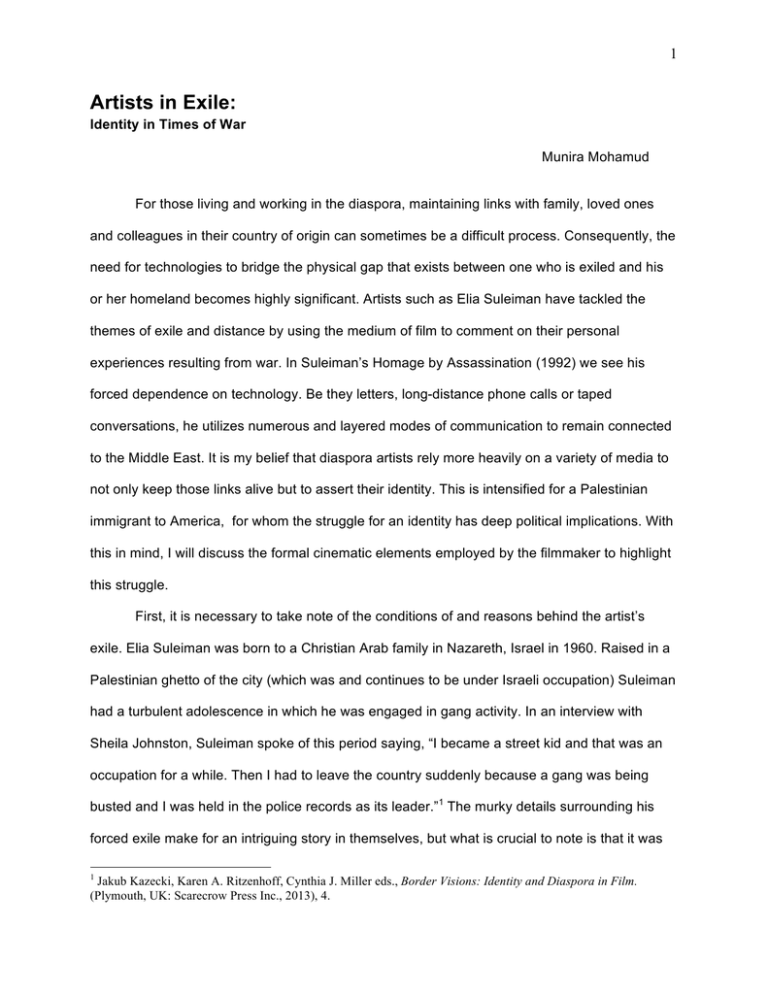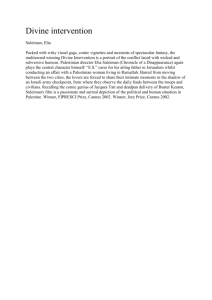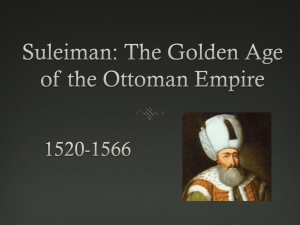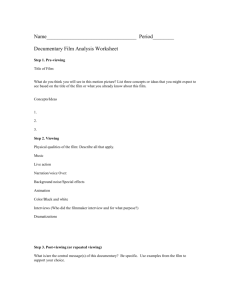Artists in Exile: 1
advertisement

1 Artists in Exile: Identity in Times of War Munira Mohamud For those living and working in the diaspora, maintaining links with family, loved ones and colleagues in their country of origin can sometimes be a difficult process. Consequently, the need for technologies to bridge the physical gap that exists between one who is exiled and his or her homeland becomes highly significant. Artists such as Elia Suleiman have tackled the themes of exile and distance by using the medium of film to comment on their personal experiences resulting from war. In Suleiman’s Homage by Assassination (1992) we see his forced dependence on technology. Be they letters, long-distance phone calls or taped conversations, he utilizes numerous and layered modes of communication to remain connected to the Middle East. It is my belief that diaspora artists rely more heavily on a variety of media to not only keep those links alive but to assert their identity. This is intensified for a Palestinian immigrant to America, for whom the struggle for an identity has deep political implications. With this in mind, I will discuss the formal cinematic elements employed by the filmmaker to highlight this struggle. First, it is necessary to take note of the conditions of and reasons behind the artist’s exile. Elia Suleiman was born to a Christian Arab family in Nazareth, Israel in 1960. Raised in a Palestinian ghetto of the city (which was and continues to be under Israeli occupation) Suleiman had a turbulent adolescence in which he was engaged in gang activity. In an interview with Sheila Johnston, Suleiman spoke of this period saying, “I became a street kid and that was an occupation for a while. Then I had to leave the country suddenly because a gang was being busted and I was held in the police records as its leader.”1 The murky details surrounding his forced exile make for an intriguing story in themselves, but what is crucial to note is that it was 1 Jakub Kazecki, Karen A. Ritzenhoff, Cynthia J. Miller eds., Border Visions: Identity and Diaspora in Film. (Plymouth, UK: Scarecrow Press Inc., 2013), 4. 2 not a voluntary move, suggesting serious legal repercussions had he remained in Nazareth. One could go further and state that his fleeing was an act of political resistance by a Palestinian refusing to acknowledge Israeli law, although it might be presumptuous to think Suleiman had any motives beyond simply wishing to avoid legal consequences. In any case, his journey led him to London, from where he went to New York at the age of 21, entering the United States as an illegal immigrant and began working menial jobs.2 Within the span of a year, Suleiman made the transition from an unruly teen in a poor Nazarene neighborhood under Israel occupation to an alleged fugitive ultimately making his way to New York illegally. This point should not be overlooked, as it is central to the questions of identity that Suleiman raises in his 1991 short film Homage by Assassination. For Suleiman to have been an illegal immigrant means that he either did not go through the necessary channels, did not have the necessary documentation proving his citizenship in some country, or both. Although Palestinian passports were only first issued by the Palestinian Authority in 1995, the United States "does recognize Palestinian Authority passports as travel documents, but does not view them as proving any type of citizenship” on the grounds that “Washington does not recognize the Palestinian Authority as a government, and only governments can confer citizenship.”3 As Suleiman entered New York in 1982, this meant he did not have a passport, and even if he had gone to the U.S. post-1995 with a Palestinian Authority passport, he would be viewed as stateless and without legally recognized citizenship. This is a theme that the filmmaker highlights throughout the short film, paying particular attention to the symbols of Palestinian nation-building and his struggle with identity. Looking at the film a bit closer, we see that Homage by Assassination serves as a window into the artist’s experience of living in New York while maintaining ties with his birthplace. Taking place over the course of one night during the 1991 Gulf War (as indicated by 2 Ibid. United States Bureau of Citizenship and Immigration Services, Palestinian Territory, Occupied: Information on Palestinian Authority passports, 20 May 2002, PSE02001.ZAR, available at: http://www.refworld.org/docid/402d150c4.html [accessed 6 December 2013]. 3 3 a title card at the beginning of the film), Suleiman plays “a Palestinian filmmaker [who] begins to question notions of identity and exile.”4 Set within the confines of his sparse but claustrophobic New York apartment, Suleiman goes through the motions of daily life. At his desk are numerous communication devices such as a fax machine, scanner, and computer to which he ventures when he is not gazing out of his window, weighing himself, or watching milk boil. These mundane activities are punctuated by the sounds of him typing Arabic proverbs on his keyboard with the typed words appearing projected onto his face. Text is an important feature of the film, which is divided by title cards that help us navigate this rather dull night in the filmmaker’s life. While the entire film cohesively speaks to the filmmaker’s struggle with identity and exile, there are particular scenes which I think illustrate these points quite effectively. As the night and story unfold, we see the different layers of his identity begin to emerge. The first glimpse into this is the first shot of the film with Suleiman crouched in his apartment corridor listening to a radio host speaking about footage of Iraqi soldiers being slaughtered by American troops as they fled Kuwait City. The host announces that he will call a young Palestinian filmmaker named Elia Suleiman, seemingly to hear his opinion on the war, and calls him while on the air. The phone at Suleiman’s feet rings and he answers, but the connection is faulty. We as the viewers, along with Suleiman, hear the host say he will try to place the call again. It rings, Suleiman answers, and the call fails once more as the host apologizes for not being able to get through to him. Although not entirely significant when taken on its own, this scene does fulfill the purpose of setting the tone of the film while foreshadowing the role (and failure) of communication technology in the filmmaker’s life. This echoes later on when he attempts to place a phone call and is told by the operator that all the phone-lines to the country he is calling are temporarily disconnected. That short scene is broken up with title cards that flash “HOLY LAND”, then “PROMISED LAND,” and finally “OCCUPIED LAND.” This short sequence of Suleiman dialing a phone, broken up by these three phrases, is very intriguing to me. I cannot help but think that 4 Homage by Assassination, directed by Elia Suleiman (New York, 1992) VHS. 4 Suleiman’s placing of the three title cards in that order was a political statement and perhaps represents his own political views with regard to Israel/Palestine. These three names are used sometimes to describe the same area of land, but there seems to be a deeper meaning in the ordering of the title cards, in that the first (HOLY LAND) is in regard to the sanctity of the land, the second (PROMISED LAND) as a hopeful term denoting the return or claiming of a land that was divinely ordained for a people, while the third (OCCUPIED LAND, also the term for the present) indicates that the promise was not fulfilled. As the Palestinian territories are in fact occupied by Israel, Suleiman might be suggesting that promise of that land was for those currently under occupation. If this is the case, Suleiman is aligning himself with many Palestinians who view themselves as an occupied people. The next scene illustrates the filmmaker’s notion of exile and the loneliness that can be caused by physical distance or separation. Here we see Suleiman at his desk typing as the sound of a revving engine draws him toward the window. He peeks through his blinds at a couple who smoke in the street below, before the man decides to drive off, leaving the woman standing alone. This moment, intercut with Suleiman’s own face, is perhaps one of my favorite moments because his own loneliness, which caused him to be a voyeur, also allowed him (or perhaps myself) to feel a strange, momentary connection to the woman who also is left alone. I feel that his standing at the window watching the couple speaks to something deeper, perhaps to his own relationships, which in the film are marked by the barrier of distance while here it is merely a window pane (in the physical sense). The scene continues on for some time during which the woman paces down the street and accidentally sets off a car alarm, all while Suleiman watches her. The reverie is broken by the abrasiveness of the alarm and the scene draws to a close. Other sequences in the film that bring attention back to the question of identity include the shot of two clocks hanging side by side on one of his apartment walls. The clock on the left, with a placard reading “Nazareth” says “2:45” while the clock on the right, “New York,” reads 5 “8:45.” This image is particularly powerful to me in that it represents the nature of exile. The one who is exiled is neither here nor there (not in the physical sense) but exists in a space in between. That the imagery he views on his TV (videos of Palestinian streets) and the old family photographs he sifts through, as well as the Arabic-language keyboard, emphasize that while he is physically in New York, a significant emotional/psychological part of him is back in Nazareth. This is also echoed to a more violent degree with the imagery of Palestinian children marching in fatigues as the sound of a rousing, perhaps nationalistic tune blares accompanied by chanting. This imagery contrasts with the static near-silence of the film up to this point, and it becomes more violent through the quickening pace of the editing, which reaches a crescendo with the music. There is something forceful about this, which I think is a comment on what nationalism and identity are in essence. The forceful assertion of one’s identity is made political when the collective asserts together. This makes Suleiman’s personal relationship with identity pale in comparison, and even he (in his reaction shots to the footage) seems oddly stunned or transfixed by the imagery. The last sequence that illustrates Suleiman’s views on identity and exile comes near the end when he receives a fax from his friend Ella Shohat. The eagerness with which he pulls the letter out of the fax machine as it is arriving is a nice touch to emphasize his longing for the communication. The title card for this scene is “A MAGIC CARPET” and the letter is narrated in voiceover by Shohat, an Iraqi Jew. The title card “A MAGIC CARPET” is intriguing because for Suleiman, this letter from his friend is a means of escape from the banality of his routine. However, the content of the letter is quite morose and does not deliver on the promise of whimsy or delight that the title suggests. Rather, she speaks of how the Gulf War has intensified the “schizophrenia” she faces with respect to her identity as a Jew and an Arab. This voiceover plays overtop black-and-white footage of a group of Arab men and women with subtitles in English, Arabic and Hebrew that read “We all belong to the Semitic race, and there is no difference between Moslem, Christian, and Jew.” The inclusivity of this messages clashes with 6 Shohat’s own story of how her family is scattered throughout the world, originally hailing from Baghdad but relocated to Israel. She recounts her sadness of having to let go of her Middle Eastern-ness, how her sisters felt pressure to conform to the European Jewish standard of beauty by dyeing their hair blonde, and how her uncles were beaten by Israelis because they were mistaken for Palestinians. One line that is very powerful is when she says that her family was “forced to repress our nostalgia.” This is very intriguing, because Suleiman throughout the film has bouts of nostalgia such as looking through family photographs or at his Nazareth clock. Perhaps he uses these objects to remain connected to his homeland when the means to communicate with his loved ones fail. Therefore, the presence of nostalgia, I believe, means the assertion of an identity, in Suleiman’s case being Palestinian. The pain in Shohat’s voice is very evident, and her own frank discussion about her complicated identity emphasizes the role of war as a destructive force not only to lives but also to the ways people retain who they are. Homage by Assassination is a beautiful film that sheds a tremendous amount of light on exile and identity for the filmmaker and other displaced people, such as Ella Shohat, whose letter illustrates the depth and significance of these issues. There is much to digest in the 26 minutes the film runs for and during that time, the affect of the film on me was at times quite visceral but also left me pondering. The overall sensation I experienced while watching this film the first time was one of boredom which flirted here and there with anticipation and anxiety. The feeling of anticipation arose during the many long takes focused on Suleiman in which he was passive in the frame, i.e., waiting for something to happen. The feeling of anxiety and unease however came about as a result of the color palette, which was as nearly always infused with amber. From the apartment, to the street below, to the close-ups of Suleiman’s face, the yellowish tinge prevailed throughout to give a sickly feel. The blue hues that also appear give the film a slightly cold look as well, perhaps reflecting Suleiman’s own feelings regarding his routine. The ghostly glow from the TV alludes to the film taking place during the night, but also is evocative of the feeling of being blue. There is a 7 melancholy to the film that runs parallel and beneath the banality of Suleiman’s activities; this really is a man pondering his place in life and how he identifies himself. If the overall mood of the film could be a color, it is clear that Suleiman and cinematographer Juan Cristobal Cobo wanted it to be cold yellows and blues. These feelings are further supported by the overall lack of camera movements in the film. Since there is no dynamism in the either the actions or camera movements, the effect is flat and boring, which is to say, effective in conveying the banality of routine. In terms of establishing the mood, the cinematographer did an excellent job in keeping a cohesive style of lighting and shooting to support the filmmaker’s vision of presenting one night in his life. The voyeuristic element of the film could have been heightened by handheld or roving camera movements, but the composed static shots work in wonderful contrast to achieve this same goal. This also, in my opinion, allows the filmmaker to keep himself from always being the subject. As with the scene of him watching the couple, the shot-reverse-shot actually aids in creating a POV feel, allowing the audience to align with the filmmaker and sympathize with his loneliness. The sound in the film is also a major contributing factor in creating mood and reflecting Suleiman’s questioning of his identity. The opening scene with the radio host, had the phone call gone through, would have had us hear the filmmaker speak in English, but he does not get the opportunity to do so. Instead, we see the title cards which Suleiman uses to guide us through his night. There is no doubt in my mind that this was a deliberate choice by the filmmaker to refrain from speaking English in the film, as it would in some way further complicate how he constructs his identity. The use of the proverbs, while unclear to an audience that does not read Arabic, since there are no accompanying subtitles, is effective if purely on an aesthetic level. Seeing the filmmaker’s language projected onto his own face is a beautiful way of emphasizing his identity as an Arab. 8 In Homage by Assassination we as the audience are brought into the artist’s experiences of living in the diaspora as he forges lines of connection to loved ones in the Middle East. Together the imagery of the film collaborates well with the soundscape, which is at times sparse, and other times bold and brash. In either case, the formal elements of the film were effective in reflecting the message laid out by Suleiman in the first title card. This film by Elia Suleiman serves to bring his audience’s attention to the physical distances created by war and exacerbated by living in exile. The lines of communication, be they letters, conversations recorded on audio cassettes, phone calls, or news broadcasts are the makeshift bridges constructed by those on either side of this gulf. All of these types of media are necessary for him to maintain that link, which is like a lifeline for him. He explores this not only through an artistic lens, but also from the perspective of a member of a displaced people often several times (physically) removed from their place of origin. Suleiman lives in a state of exile further complicated by the precarious and ever-changing status of Palestinian citizenship, which I believe plays a major role in the direction of this film. To me, there is something intrinsically political about this film as the questions of identity and exile are raised but not easily answered. 9 References Homage by Assassination. Directed by Elia Suleiman. New York, 1992. VHS. Kazecki, Jakub, Ritzenhoff, Karen A. and Cynthia J. Miller, eds. Border Visions: Identity and Diaspora in Film. Plymouth, UK: Scarecrow Press Inc., 2013. Naficy, Hamid. An Accented Cinema: Exilic and Diasporic Filmmaking. Princeton: Princeton University Press, 2001. Shohat, Ella and Robert Stam. Unthinking Eurocentrism: Multiculturalism and the Media. New York: Routledge, 1994. United States Bureau of Citizenship and Immigration Services. Palestinian Territory, Occupied: Information on Palestinian Authority passports. 20 May 2002, PSE02001.ZAR, available at: http://www.refworld.org/docid/402d150c4.html [accessed 6 December 2013]20 May 2002.






